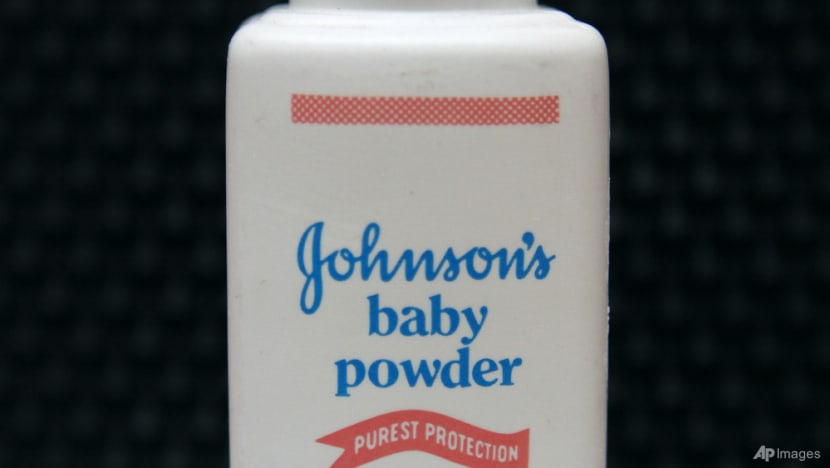FAQ: Johnson & Johnson to end sale of talc-baby powder amid safety concerns. Why are people worried about talc?

A bottle of Johnson's baby powder is displayed in San Francisco. (File photo: AP Photo/Jeff Chiu)
Healthcare giant Johnson & Johnson (J&J) announced on Thursday (Aug 11) that it will end sales of its talc-based baby powder globally in 2023, a product which has drawn thousands of consumer safety lawsuits in the US.
The company said it has “made the commercial decision” to transition to a cornstarch-based baby powder portfolio, which is sold in countries around the world.
J&J previously announced in 2020 that it would stop sales of its talc-based baby powder in the US and Canada due to fallen demand in the wake of what the company called “misinformation” about the product’s safety, amid a barrage of legal challenges.
The company faces about 38,000 lawsuits from consumers and survivors claiming its talc products caused cancer due to contamination with asbestos, a known carcinogen. J&J has denied the allegations, saying that decades of scientific testing and regulatory approvals have shown its talc and asbestos-free.
WHAT IS TALC USED IN?
According to the US Food & Drug Administration (FDA), talc is a naturally occurring mineral mined from the earth. It is used mostly in cosmetics and other personal care products as it can be used to absorb moisture or to improve the feel of a product.
While published scientific literature has suggested a possible use of powders containing talc in the genital area and the incidence of ovarian cancer, the studies have not “conclusively demonstrated such a link, or if such a link existed, what risk factors might be involved”, said FDA.
The mineral has also been found in close proximity in the earth to another mineral, asbestos.
HOW IS ASBESTOS HARMFUL TO US?
Asbestos, like talc, is a naturally occurring silicate mineral but with a different crystal structure. It is sometimes found in close proximity to talc but unlike the latter, is a known carcinogen when inhaled. There is potential for contamination of talc with asbestos, said the FDA.
According to the National Environment Agency, asbestos is used to manufacture building materials, friction and insulation products. The mineral is composed of fibrous silicates, which gives it high tensile strength and good heat and fire resistance.
However, inhaling asbestos fibres can cause serious diseases such as lung cancer, mesothelioma or a cancer of the chest and abdominal lining, and asbestosis, the fibrosis of lung tissues.
The use of asbestos materials in buildings and the import of raw asbestos have been banned in Singapore since the late 1980s.
WHAT TESTS HAVE BEEN DONE ON ASBESTOS IN TALC?
The FDA said it has continued its testing for asbestos contamination in talc-containing cosmetic products, which were selected based on various factors including the type, price range, popular products on social media and advertisements, and those marketed towards children.
In the latest FDA update in 2021, the agency released results of its testing on products containing talc for the presence of asbestos.
A total of 50 samples were tested in 2021 and asbestos fibres were not detected in any of them.
One research paper published in 2008 stated that measures of internal talc exposure such as talc-dusted diaphragms and latex condoms showed no relationship with ovarian cancer risk. It added that models studies had not found evidence for a carcinogenic effect.
Related:
WHAT WENT ON DURING THE J&J LAWSUITS?
A 2018 Reuters investigation showed that the company had known for decades about asbestos in its talc products.
According to the report, internal company records, trial testimony and other evidence showed that from at least 1971 to the early 2000s, J&J's raw talc and finished powders sometimes tested positive for small amounts of asbestos.
In 2018, a woman claimed that her ovarian cancer was caused by using J&J’s baby powder for decades. She and 21 other women were paid a total of US$4.7 billion in damages, Reuters reported.
A St Louis jury concluded that J&J’s talc-based products contained asbestos, causing the 22 women, six of whom had died, to develop ovarian cancer.
The St Louis trial was the first to allege that asbestos-contaminated talc caused ovarian cancer, which the company had consistently denied and had successfully overturned prior verdicts.
In another lawsuit, J&J was ordered by a New York state judge to pay US$120 million in damages to a woman in Brooklyn and her husband, after she blamed her cancer on asbestos exposure from using its baby powder.
IS THERE ASBESTOS IN THE J&J TALC POWDERS SOLD IN SINGAPORE
In 2019, the Health Sciences Authority said no traces of asbestos were detected in J&J talcum powders sold in Singapore.
Under the cosmetic product regulation, the use of asbestos in products like baby powder is prohibited in Singapore.
HSA added then that J&J submitted regular test reports which showed the absence of asbestos in their products sold in Singapore.














